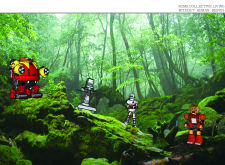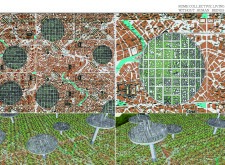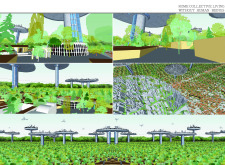5 key facts about this project
The design presents a vision for a future collective living space located in Rome. It explores the idea of habitation beyond human inhabitants, focusing instead on robotic entities within the urban landscape. The proposal challenges conventional notions of community, emphasizing the relationships among humans, nature, and technology. By reimagining the role of buildings and public spaces, it aims to offer a thoughtful response to the ongoing changes in ecological and social dynamics.
Conceptual Framework
The design is rooted in the historical context of Rome, connecting the past with a speculative future. It envisions the remnants of human architecture being reconfigured as homes for robots, creating a collective living environment independent of human presence. This vision draws on philosophical ideas about advancement and existence, suggesting that robots will become the new stewards of urban spaces. It raises questions about what community means when human beings are no longer at the center of design thinking.
Ecological Reclamation
By confronting the ecological consequences of human activity, the proposal highlights the possibility of nature reclaiming urban areas. The design illustrates a mutually beneficial relationship between robots and the environment. Green spaces are anticipated to flourish alongside robot habitation. This vision suggests that urban environments can be revitalized through an integration of technology and nature, leading to a healthier ecosystem where both can thrive.
Future Living Dynamics
The community dynamics focus on the interactions between robotic entities and their environment. The design addresses how these relationships will shape everyday life in this new urban setting. It imagines a framework where robots not only coexist with nature but also interact with one another in meaningful ways. This perspective encourages deeper thinking about the implications of artificial intelligence and automation on the future of urban living.
The project uses visuals to illustrate a unique architectural identity that integrates natural elements with technological advancements. It promotes the idea of reusing existing structures and emphasizes the importance of sustainability. In doing so, it invites reflection on how future urban designs can support both ecological balance and innovative living experiences, allowing for a harmonious coexistence within the environment.






















































